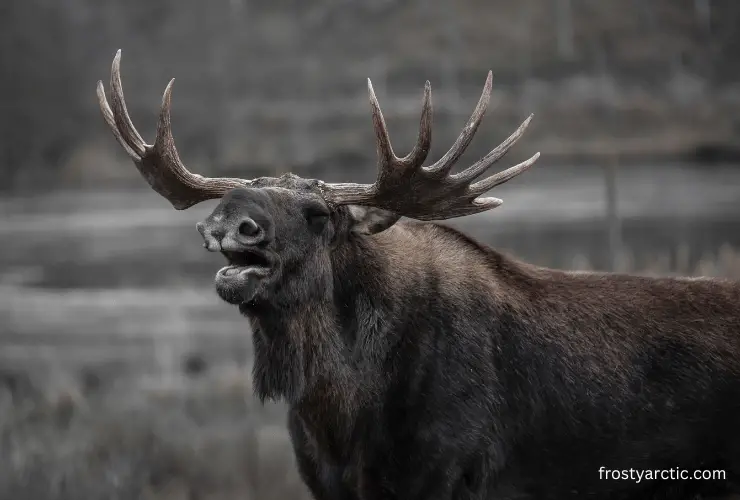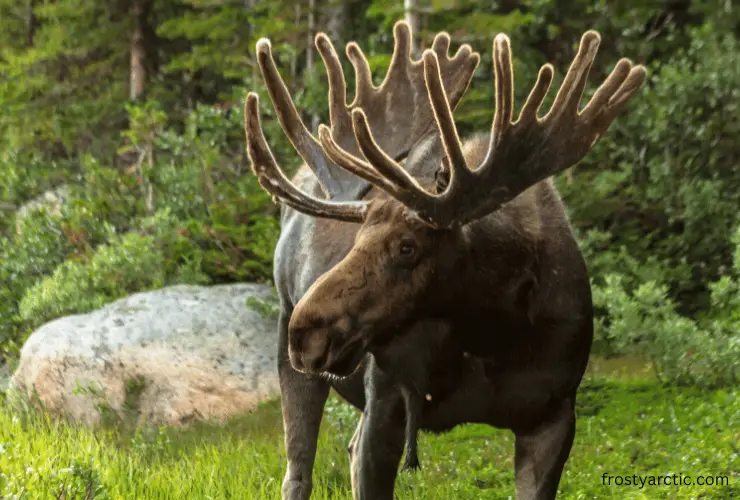Yes, like cows, moose have four-chambered stomachs with four compartments, including the rumen, reticulum, abomasum, and omasum. They bring swallowed, partially digested food to their mouth and chew it again to break down their food before swallowing it again. This aids digestion.
Did you know that moose digestive systems are similar to that of cattle? These animals have a special diet, including bark and wood. So, they are equipped with a four-chambered stomach to digest food properly.
This article covers some intriguing information about moose and their digestive system. So, let’s get started!
How Many Animals Have Four Stomachs?
A ungulated mammal with a four-chambered stomach is known as a ruminant. Such animals include antelopes, giraffes, cattle, sheep, and deer. Since moose belong to the deer family, they are also ruminants.

Did you know? Ruminants have two-toed feet and hooves and do not have upper incisors. In some cases, however, they have reduced upper incisors. ~ Britannica
The animals mentioned above feed on plant material such as foliage and grasses. However, their digestive system does not produce the enzymes required to break them down directly.
In other words, they cannot digest plant material directly. Thus, the four-chambered stomach helps them digest these plant substances.
Do Moose Have 4 Stomachs? Why Do They Have 4 Stomachs?
Yes, moose have four stomachs. Let’s discover the function of their four-chambered stomach and how it helps in digestion.
The Function of Moose Stomachs
Their four-compartment stomach includes:
1. Rumen:
The rumen is the largest chamber of a moose’s stomach. It primarily stores the feed consumed by moose. This chamber is also responsible for the production of microbes and creating balls of cud. Microbes break down protein.

Rumen absorbs nutrients by breaking down cellulose through symbiotic microorganisms. This chamber also aids the fermentation process.
The rumen does not just store the smaller digested particles and transfers them to the next chamber for further digestion. However, it retains the larger particles for further digestion.
2. Reticulum:
Fun Fact: The reticulum has a structure shaped just like a honeycomb. Thus, it is also referred to as the honeycomb.
Research suggests that the reticulum has a capacity of about 5 gallons. The rumen and reticulum serve the same purpose. Thus, they are considered the same organ. A small muscular fold tissue separates the two compartments.
The primary function of this chamber is to collect the smaller particles and transfer them to the next compartment.
3. Omasum:
The omasum is composed of leaf-like structures similar to the pages of a book. This globe-shaped structure is responsible for water absorption from digestive contents.
Its unique structure increases surface area, ensuring nutrients and water are absorbed effectively from the food ingested by moose.
The omasum also serves the following functions:
- Fermentation of ingesta
- Absorbing fatty acids, water, and minerals
- Transfers appropriately sized feed particles from the reticulum to the abomasum
4. Abomasum:
The abomasum is also called the “true stomach,” which produces essential enzymes to break down the food substances that the moose has consumed. For instance, it produces hydrochloric acid and pepsin, which breaks down protein.
The abomasum also receives digestive enzymes, including pancreatic lipase from the pancreas, which breaks down fats. Thus, the true stomach.
Moose Digestive System
A moose’s digestive system is composed of the following parts:
Mouth:
The mouth is the first part of the digestive system. Moose use their mouth (including their teeth and tongue) to ingest plant material.
Using its teeth, it harvests forages by wrapping its tongue around plants and tearing them for consumption.

Salivary glands present in the mouth produce saliva, which helps break down starch present in the food ingested. Saliva also softens the greens consumed by moose, helping it form a bolus that the animal can swallow effectively.
Incisors are usually absent in a moose’s mouth. The roof of the mouth is a hard palate, while the lower jaw incisors grind against this pad.
Esophagus:
The esophagus is a narrow tube-like passage that connects the moose’s four-chambered stomach to its mouth.
The bolus consists of forage mixes, potassium, sodium, phosphate, bicarbonate, and urea and passes through the esophagus to the stomach.
Pressure fluctuations and muscle contractions in the esophagus aid the process of swallowing and moving food down to the rumen.
What Happens Next?
Moose need to chew their food more effectively. Their esophagus functions bidirectionally, regurgitating the cud back to their mouths, allowing them to chew further.
This cud is swallowed again for further digestion, traveling to the reticulum through the esophagus.
The solid particles remain in the rumen for fermentation. The liquid part is moved to the reticulorumen, the next chamber, and so on.
Rumen holds the solid particles for at least 48 hours, during which it forms a heavy mat in this chamber.
Do Elk Have 4 Stomachs?
Yes, moose are also ruminants which means they have a four-compartment stomach just like moose.
In fact, moose and elk are the same species. However, the Wappitti, another member of the moose family, is called the elk in North America.
Despite its biological origins, all members of the deer family (including elk and moose) are ruminants.
FAQ:
How much water does a moose drink a day?
Moose have been observed consuming large quantities of water in the summer season. Their water consumption remains low in winter.
How much does a moose eat per day?
A moose consumes nearly 40 to 60 pounds of food in a day. Salt is one of the most essential food requirements for moose.
What Do Moose Eat? Can Moose Digest Wood?
Moose are herbivores which means they only eat plants. In winter, when plant material is scarce, these animals also eat wood, including twigs, tree bark, etc.
Conclusion
Moose means “twig eater” in the Algonquin language. In other words, these creatures are herbivores whose diet consists of willows, shrubs, and even wooden materials! They need to consume about 10,000 calories daily.
To digest what they consume, these animals have a special digestive system consisting of a four-compartment stomach.
I hope this article helped clear your confusion about the moose digestive system.


